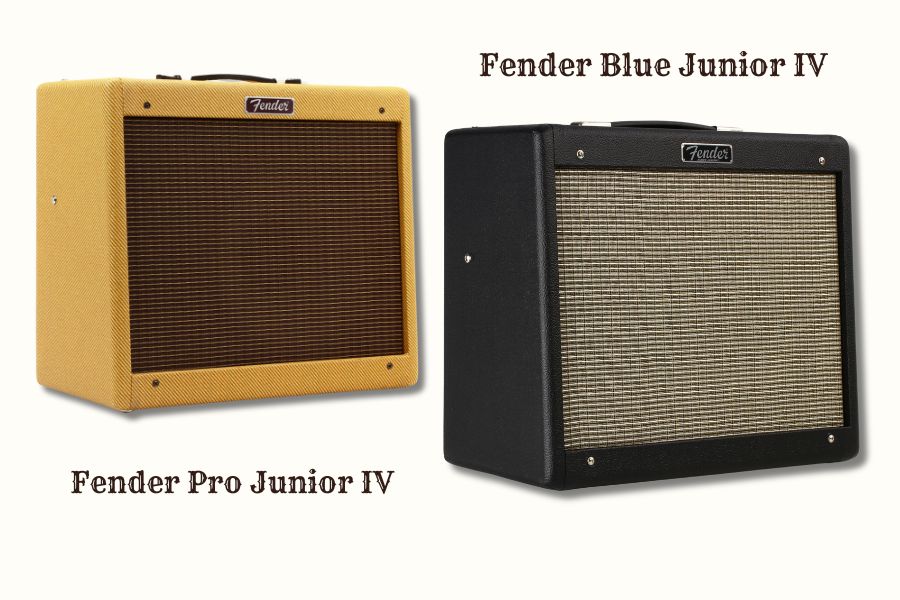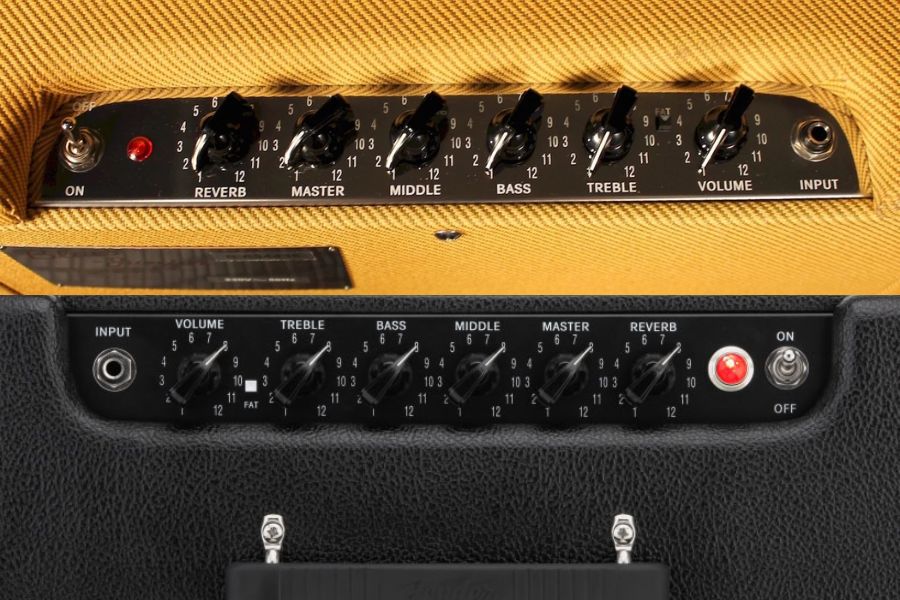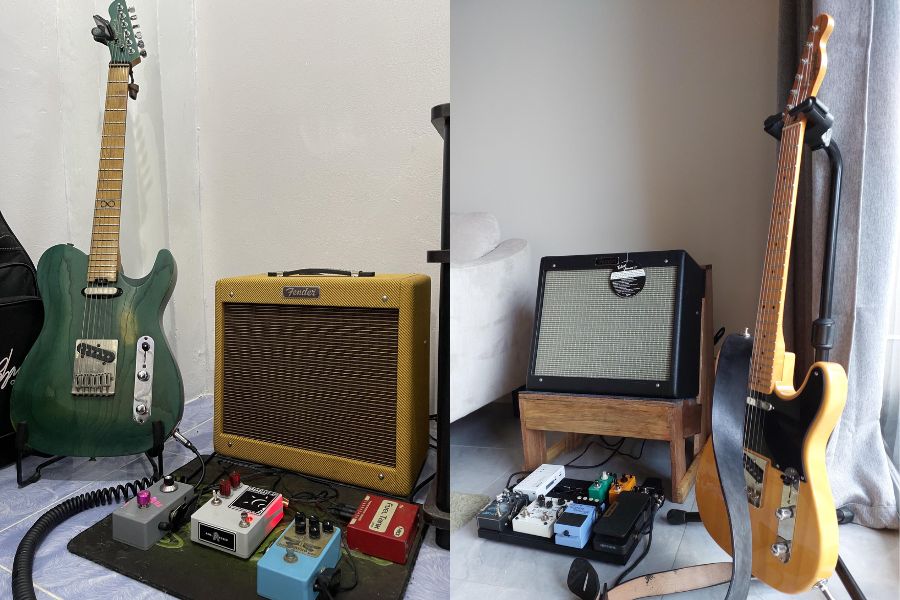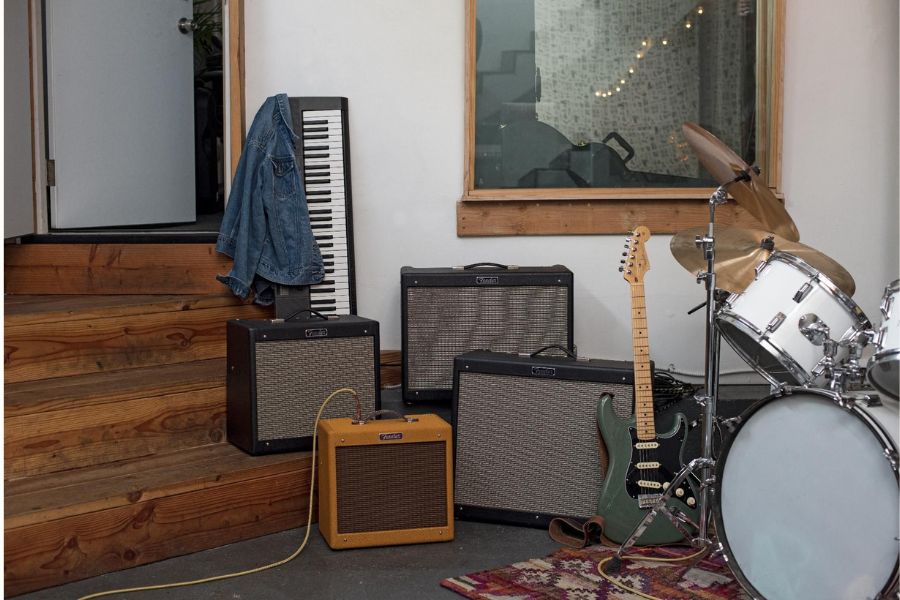The Fender Blues Junior and Pro Junior are indeed among the most popular and highly regarded amplifiers in Fender’s lineup, especially for players seeking compact, tube-driven tones. Today, let’s take a closer look at how these products from the same brand differ.
Fender Blues Junior Vs Pro Junior
| Attribute | Fender Pro Junior IV | Fender Blues Junior IV |
| Power Output | 15 watts | 15 watts |
| Speaker Size | 1×10-inch Jensen P10R | 1×12-inch Celestion A-type |
| Preamp Tubes | 2x 12AX7 | 3x 12AX7 |
| Power Amp Tubes | 2x EL84 | 2x EL84 |
| Rectifier | Solid-state | Solid-state |
| Control Panel | Volume, Tone | Volume, Fat Switch, Bass, Middle, Treble, Master, Reverb |
| Weight | 20.5 lbs | 31.5 lbs |
| Dimensions (H x W x D) | 14.5″ x 15.25″ x 8.75″ | 16″ x 18″ x 9.18″ |
| Covering Material | Lacquered Tweed | Black Textured Vinyl |
| Grill Cloth | 1950s Style | Lightly-Aged with Sparkle |
| Included Accessories | None | Footswitch for Fat Switch |
| Ideal Use | Simplicity and pure tone | Versatility and detailed tone shaping |
Configure Amplifier
There are many factors to consider when it comes to amps, such as how they were set up at the factory and how the user feels about them. Let us go over these two types’ specifics so you can decide which one to pick. The first part is the setup, which has information about the machine and the specific choices for each type that determine how well it works.

Power Output
Both amps have 15 watts of tube-driven output, which is enough power and sound impact for practice and live shows in small to medium-sized rooms.
Speaker Size
The Pro Junior IV has a 1×10-inch Jensen P10R speaker that makes sound that is tight and focused, with clear highs and a strong midrange.
Blues Junior IV: It has a bigger 1×12-inch Celestion A-type speaker that makes the sound louder and more responsive to a wider range of frequencies. This makes it better for playing a wider range of music styles.
Tube Configuration
The preamp stage of the Pro Junior IV has two 12AX7 tubes and the power amp stage has two EL84 tubes. This gives it sweet, classic rock tones with a mix of clarity and distortion.
Blues Junior IV: It has a similar setup for its power amp tubes, but it also has a 12AX7 preamp tube, which gives it a deeper, more complex preamp gain structure that lets you change the sound even more.
Rectification Type
Solid-state rectifiers give both types a more sensitive sound with less lag than tube-rectified amps. This makes them perfect for guitarists who want a faster attack and clearer notes.
Control Panel Design

The Pro Junior IV’s control panel is very simple, with just two “chickenhead” buttons for level and tone. This makes it perfect for players who want to quickly shape and set up their sounds.
The Blues Junior IV has a bass, middle, treble, and master volume knob, as well as a “fat” switch for midrange boost. This extra set of controls gives you more sound choices and finer control over the tone.
The User Experience
It’s important to know what the original settings are, but it’s also important to know how players feel and experience these amps.

Aesthetic Appeal
Guitar amplifiers are both utilitarian and artistic, which are the guitarist’s flair. Fender Pro Junior and Blues Junior designs suit different interests.
Pro Junior: It looks like an old Fender with its shiny tweed cover and grill cloth from the 1950s. In the 1950s and 1960s, when rock & roll was just starting out, glossy tweed was often used to cover guitar amps and other musical gear.
Blues Junior: If you like a sleek, modern look, the Blues Junior has black smooth vinyl and slightly worn-in fabric.
Functional Features
Blues Junior: Mastery in Sound Sculpting
3-Band EQ & Reverb: These let you precisely shape the tone of any style, and the built-in noise adds color and depth.
Master Volume & Fat Switch: Let you control the volume and instantly improve the sound, a wide range of playing styles and settings.
Versatile Toolkit: A full set of settings for finely tuning the sound, meeting current musicians.
Pro Junior: Getting in Touch with the Pure Essence of Guitar Tone
The volume and tone controls: The level and tone settings make it easy to change the tone, which brings out the guitar’s natural sound and the skill of the player.
Simplified Signal Path: Makes sure the tone is clear and uncolored, which is great for pedals and pure guitar sounds .
Easy to Use: People who want real amp tones with little work will like this easy plug-and-play way.
Tonal Characteristics
The clean and overdriven sounds of a standard Fender amp can be achieved by both amps, but they are designed to suit different tastes:

Blues Junior gives you a lot of options and control
Fuller sound and on-board controls: The Blues Junior has more volume and a wider range of tones thanks to its bigger 12-inch speaker and extra preamp tube. Players can easily try everything from clean, clear sounds to overdriven, distorted sounds. There are many sounds that can be played through this amp, and it’s not too loud. In this way, it’s very useful both in the studio and live.
Better low-end and midrange complexity: The Blues Junior’s EQ part has separate settings for bass, middle, and high, so you can fine-tune the sound. This gives the low end and midsection more depth. Some sounds are very complex and detailed, and they can work in any mix. They can also be used in different settings.
Built-In Fat Switch and Spring Reverb: The fat switch boosts the middle right away, which makes the distortion tones sound better and the leads stand out. There is more depth and loudness with the spring echo. The Blues Junior can be used to play a lot of different kinds of music.
Pro Junior: Genuine Openness and Response
Open and Organic Tone: Clean, clear tones that get overdriven with a lot of harmonics as the volume goes up. This amplifier accurately copies the sound of an electric guitar and responds instantly to the player’s touch.
Volume Dependence: The Pro Junior’s simple circuitry and 10-inch speaker-tube amp part make the tone lively at higher volumes. The raw sound of the guitar and the skill of the player are brought out.
Ideal for Pedal Fans: The Pro Junior’s simple controls and effective signal paths make it perfect for pedal-based setups, letting outside effects shape the amp’s sound without changing it.
Final Consideration
The decision between these two amplifiers hinges on personal preference and specific needs. Pro Junior is praised for its ease of use and pedal friendliness, perfect for those who rely on external effects for tone shaping.
Blues Junior is valued for its built-in features like reverb and the fat switch, making it a more standalone solution for varied playing situations without the need for many pedals.


